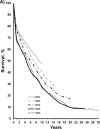Trends in 10-year survival of patients with stroke hospitalized between 1980 and 2000: the Minnesota stroke survey
- PMID: 25028450
- PMCID: PMC4768867
- DOI: 10.1161/STROKEAHA.114.005512
Trends in 10-year survival of patients with stroke hospitalized between 1980 and 2000: the Minnesota stroke survey
Abstract
Background and purpose: We report on trends in poststroke survival, both in the early period after stroke and over the long term. We examine these trends by stroke subtype.
Methods: The Minnesota Stroke Survey is a study of all hospitalized patients with acute stroke aged 30 to 74 years in the Minneapolis-St Paul metropolis. Validated stroke events were sampled for survey years 1980, 1985, 1990, 1995, and 2000 and subtyped as ischemic or hemorrhagic by neuroimaging for survey years 1990, 1995, and 2000. Survival was obtained by linkage to vital statistics data through the year 2010.
Results: There were 3773 acute stroke events. Age-adjusted 10-year survival improved from 1980 to 2000 (men 29.5% and 46.5%; P<0.0001; women 32.6% and 50.5%; P<0.0001). Ten-year ischemic stroke survival (n=1667) improved from 1990 to 2000 (men 35.3% and 50%; P=0.0001; women 38% and 55.3%; P<0.0001). Ten-year hemorrhagic stroke survival showed a trend toward improvement, but this (n=489) did not reach statistical significance, perhaps because of their smaller number (men 29.7% and 45.8%; P=0.06; women 39.2% and 49.6%; P=0.2). Markers of stroke severity including unconsciousness or major neurological deficits at admission declined from 1980 to 2000 while neuroimaging use increased.
Conclusions: These poststroke survival trends are likely because of multiple factors, including more sensitive case ascertainment shifting the case mix toward less severe strokes, improved stroke care and risk factor management, and overall improvements in population health and longevity.
Keywords: epidemiology; stroke; survival.
© 2014 American Heart Association, Inc.
Conflict of interest statement
None
Figures


References
-
- Goff DC, Jr, Brass L, Braun LT, Croft JB, Flesch JD, Fowkes FG, et al. Essential features of a surveillance system to support the prevention and management of heart disease and stroke: a scientific statement from the American Heart Association Councils on Epidemiology and Prevention, Stroke, and Cardiovascular Nursing and the Interdisciplinary Working Groups on Quality of Care and Outcomes Research and Atherosclerotic Peripheral Vascular Disease. Circulation. 2007;115:127–155. - PubMed
-
- Shahar E, McGovern PG, Pankow JS, Doliszny KM, Smith MA, Blackburn H, et al. improved survival of stroke patients during the 1980s. The Minnesota Stroke Survey. Stroke. 1995;26:1–6. - PubMed
-
- McGovern PG, Pankow JS, Burke GL, Shahar E, Sprafka JM, Folsom AR, et al. Trends in survival of hospitalized stroke patients between 1970 and 1985. The Minnesota Heart Survey. Stroke. 1993;24:1640–1648. - PubMed
Publication types
MeSH terms
Grants and funding
LinkOut - more resources
Full Text Sources
Other Literature Sources
Medical

